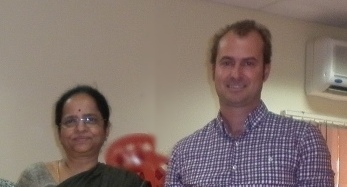Introduction
I was grateful to recieve the Bhati Family Travel Grant which allowed me to travel to Chennai, India in October to meet with experts on Drought and Suicide there. I wanted to go to India to help me with my work on Farmer Suicide in Australia primarily because I’d read about the excellent researchers there and also the large magnitude of the problem with farmer suicide and drought (it is in the news media quite regularly).
I arrived on 2nd October and the airport and streets were pretty quiet. I think because this is a public holiday in honour of Gandhi.
I had previously arranged to meet
- Dr L Vijayakumar founder of Society for Natal Effects on Health - SNEHA and
- Dr A Nambi+, Director of the Climate Change Program and Dr R Rukmani, Director of the Food Security Program at M S Swaminathan Research Foundation - MSSRF.
This is my re-written notes of both meetings.
First Meeting: 3rd October, Dr Lakshmi Vijayakumar
Dr Lakshmi Vijayakumar is a WHO expert, a practicing psychiatrist and founder of the SNEHA suicide prevention organisation.

When I contacted her to ask for a meeting she invited me to come to the headquarters of SNEHA in R A Puram, south central Chennai. The Autorickshaw driver took a couple of wrong turns but we got there OK after asking directions. I also met Jyothi the SNEHA Director and several volunteers who work at the centre and befriend people who visit or phone with suicidal problems.

I had asked to visit because I’ve been following her research on farmer suicide prevention measures. I suggested that my research on Drought-specific causality might benefit from insights that Dr Vijayakumar could give me, and thankfully she agreed to give me her time. I was very pleased she mentioned that she found my research “interesting and important” which is great because that is just the way I feel about HER research.
I reflected on my way to the meeting what I want to get out of this lesson and I felt that it was really important to get feedback on some of the directions I want to pursue in terms of a unified theoretical framework across environmental and social causes of suicide (generalised across diverse social situations like the differences between Australian and Indian Farmers).
I also felt it was important that I might just sit and listen to any advice Dr Vijayakumar felt like giving me, so I asked what she thought were the most important priorities for farmer suicide research in India. I have been reflecting on the influence of Dr Vijayakumar’s words had on me when I heard them on a Radio report by Australian Journalist Michael Condon Ref when he came to India in 2009.
My Secret Agenda
I brought along a secret agenda which was to get an opinion of my preconceived thoughts about the topic. Particularly the approach to a generalised framework of the work of my PhD supervisors Colin, Phil and Rohan for disentangling environmental from social impacts on health. Especially this framework is for understanding tipping points in the farmer suicide system. My second secret agenda was that if the framework I presented was thought OK, then what were the best next steps (plan for the future), in terms of communication in suicide prevention fields, actions in policy arenas and etc.
First: I presented the general framework. The essence of this is the “Five Capitals”:
- Financial
- Social
- Physical
- Natural
- Human
Phil and Rohan have developed approaches aimed at Rural Livelihoods and Adaptive Capacity of Farmers. Colin had extended this even to the concept of Human Carrying Capacity. I think this framework especially useful for tipping points because the causes of such catastrophes are undoubtedly numerous, interacting and dynamic.
So what did Lakshmi think? She started by saying that it made good sense, that the main focus of suicide prevention work was focused on the biological, psychological and social domains. But there are so many other factors. Drought was clearly one.
She got out a map of the recent suicide rates and showed me a region of elevated risk north-west of Tamil Nadu, south of Chatinargarth, and north of Kerala. 60 percent of India’s farmer suicides are in these states. Why are these 3 states high but TN is not? All are semi-arid.
All have similar societies, cultures, climates, agriculture, etc. We tried fitting these to the five capitals framework.
1 dev-table
| Capital | Semi-arid suicide hotspot | Tamil Nadu |
|---|---|---|
| Financial | move from rice/millet/polyculture | remained polyculture |
| into cashcrops, cotton, chilli | ||
| with more pesticide, decreased access | ||
| to local money lender and more reliance | ||
| on international corporations | retained local lending, | |
| more responsive to seasonal | ||
| conditions |





